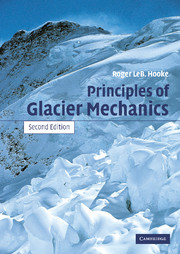Book contents
- Frontmatter
- Contents
- Preface to the first edition
- Preface to the second edition
- Physical constants relevant to ice
- Derived SI units and conversion factors
- 1 Why study glaciers?
- 2 Some basic concepts
- 3 Mass balance
- 4 Flow and fracture of a crystalline material
- 5 The velocity field in a glacier
- 6 Temperature distribution in polar ice sheets
- 7 The coupling between a glacier and its bed
- 8 Water flow in and under glaciers: geomorphic implications
- 9 Stress and deformation
- 10 Stress and velocity distribution in an idealized glacier
- 11 Numerical modeling
- 12 Applications of stress and deformation principles to classical problems
- 13 Finite strain and the origin of foliation
- 14 Response of glaciers to changes in mass balance
- Appendix: Problems
- References
- Index
4 - Flow and fracture of a crystalline material
Published online by Cambridge University Press: 24 November 2009
- Frontmatter
- Contents
- Preface to the first edition
- Preface to the second edition
- Physical constants relevant to ice
- Derived SI units and conversion factors
- 1 Why study glaciers?
- 2 Some basic concepts
- 3 Mass balance
- 4 Flow and fracture of a crystalline material
- 5 The velocity field in a glacier
- 6 Temperature distribution in polar ice sheets
- 7 The coupling between a glacier and its bed
- 8 Water flow in and under glaciers: geomorphic implications
- 9 Stress and deformation
- 10 Stress and velocity distribution in an idealized glacier
- 11 Numerical modeling
- 12 Applications of stress and deformation principles to classical problems
- 13 Finite strain and the origin of foliation
- 14 Response of glaciers to changes in mass balance
- Appendix: Problems
- References
- Index
Summary
Before proceeding to a more theoretical discussion of the dynamics of glaciers, it will be useful to present a brief introduction to the voluminous literature on deformation or creep of ice. We will begin by looking at deformation processes on an atomic scale and then introduce empirical and semi-empirical relations that provide a macroscopic description of the deformation. Finally, we will show how principles of linear fracture mechanics can be used to predict crevasse depth.
Crystal structure of ice
There are nine known crystalline forms of ice, but seven of them are stable only at pressures in excess of about 200 MPa, and the eighth, a cubic form, ice Ic, is stable only at temperatures below about -100°C (Figure 4.1). As the highest pressures and lowest temperatures in glaciers on Earth are about 40 MPa and -60°C, respectively, these eight forms need not concern us. We thus restrict our attention to the common form of terrestrial ice, ice Ih.
The structure of ice Ih is shown, in stereoscopic view, in Figure 4.2a. It is a hexagonal mineral (hence the “h”) with a rather open structure in which every oxygen atom, represented by the large circles in Figure 4.2a, is bonded to four additional oxygen atoms at the corners of a tetrahedron. The tetrahedra are joined together in such a way that the oxygens form hexagonal rings with the O=O bonds zigzagging lightly up and down as one progresses around the ring (Figure 4.2b); three of the oxygens thus lie 0.09 nm above the other three.
- Type
- Chapter
- Information
- Principles of Glacier Mechanics , pp. 43 - 75Publisher: Cambridge University PressPrint publication year: 2005



